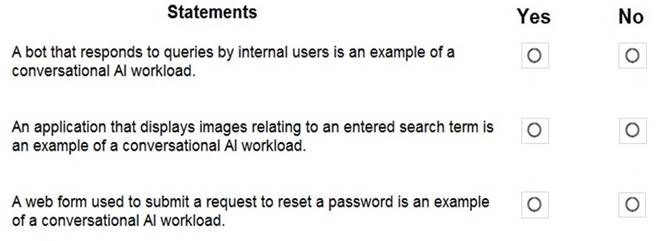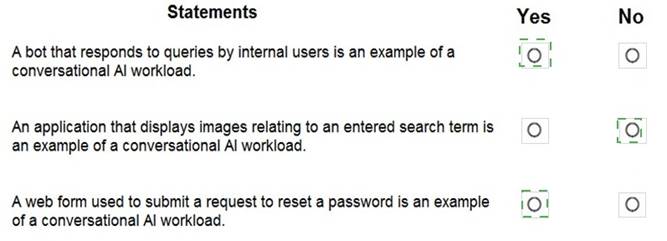- (Topic 1)
What are three Microsoft guiding principles for responsible AI? Each correct answer presents a complete solution.
NOTE: Each correct selection is worth one point.
Correct Answer:
CDF
Reference:
https://docs.microsoft.com/en-us/learn/modules/responsible-ai-principles/4-guiding- principles
- (Topic 2)
A medical research project uses a large anonymized dataset of brain scan images that are categorized into predefined brain haemorrhage types.
You need to use machine learning to support early detection of the different brain haemorrhage types in the images before the images are reviewed by a person.
This is an example of which type of machine learning?
Correct Answer:
C
Reference:
https://docs.microsoft.com/en-us/learn/modules/create-classification-model-azure-machine-learning-designer/introduction
- (Topic 5)
Which two scenarios are examples of a conversational AI workload? Each correct answer presents a complete solution.
NOTE: Each correct selection is worth one point.
Correct Answer:
BC
B: A bot is an automated software program designed to perform a particular task. Think of it as a robot without a body.
C: Automated customer interaction is essential to a business of any size. In fact, 61% of consumers prefer to communicate via speech, and most of them prefer self-service. Because customer satisfaction is a priority for all businesses, self-service is a critical facet of any customer-facing communications strategy.
Reference:
https://docs.microsoft.com/en-us/azure/architecture/data-guide/big-data/ai-overview
https://docs.microsoft.com/en-us/azure/architecture/solution-ideas/articles/interactive-voice- response-bot
HOTSPOT - (Topic 5)
For each of the following statements, select Yes if the statement is true. Otherwise, select No.
NOTE: Each correct selection is worth one point.
Solution:
Does this meet the goal?
Correct Answer:
A
DRAG DROP - (Topic 2)
Match the machine learning tasks to the appropriate scenarios.
To answer, drag the appropriate task from the column on the left to its scenario on the right. Each task may be used once, more than once, or not at all.
NOTE: Each correct selection is worth one point.
Solution:
Box 1: Model evaluation
The Model evaluation module outputs a confusion matrix showing the number of true positives, false negatives, false positives, and true negatives, as well as ROC, Precision/Recall, and Lift curves.
Box 2: Feature engineering
Feature engineering is the process of using domain knowledge of the data to create features that help ML algorithms learn better. In Azure Machine Learning, scaling and normalization techniques are applied to facilitate feature engineering. Collectively, these techniques and feature engineering are referred to as featurization.
Note: Often, features are created from raw data through a process of feature engineering. For example, a time stamp in itself might not be useful for modeling until the information is transformed into units of days, months, or categories that are relevant to the problem, such as holiday versus working day.
Box 3: Feature selection
In machine learning and statistics, feature selection is the process of selecting a subset of relevant, useful features to use in building an analytical model. Feature selection helps narrow the field of data to the most valuable inputs. Narrowing the field of data helps reduce noise and improve training performance.
Does this meet the goal?
Correct Answer:
A

